Puppies have a lot of hyper energy and very short attention spans.
They are also infinitely curious and want to put everything that they see in their little mouths. This can make puppy obedience training something of a challenge.
When it comes to puppy training, we want to get our puppy to repeat good behaviors, and stop bad behaviors. The more a puppy practices a behavior, the more likely she will repeat it. Therefore, by encouraging good behaviors, we ensure that she will have a good repertoire of people friendly actions to draw upon when she grows up.
Here, we deal with the 3 primary elements of puppy obedience training –
- How to communicate consistently and effectively with a puppy.
- How to encourage good puppy behaviors.
- How to discourage bad puppy behaviors.

1. How to Communicate with Puppy

The first two words I teach my puppy are “Yes” and “No”.
“Yes” is used to mark a desirable behavior and “No” is used to mark an undesirable behavior.
Yes is usually followed by a positive consequence (e.g. a food reward, affection, toys), and No is usually followed by a negative consequence (e.g. withdrawal of attention, timeout).
In fact, we do not need to use the words “Yes” and “No”, and can pick whatever mark-words we want. The best mark-words are unique, and do not frequently come up in normal conversation. This helps to prevent confusion with our dogs.
For my dogs, I use Ack-Ack as a no-mark and Good-Boy or Good-Girl as a yes-mark.
- When my puppy does something good, I say “Good-Girl” and present her with a small treat reward.
- When my puppy does something bad, I say “Ack-Ack” and redirect her into doing something positive.
Consistency is very important while communicating with our dogs. We want to stick to the same yes-mark and no-mark.
In addition, we also want to establish very consistent rules and a fixed routine. This helps our puppy understand what is expected of her, as well as what she can expect from us.


One of the first things that I do with a new puppy, is set up a fixed routine. My puppy schedule includes playing time, training time, walking time, feeding time, and the ever important sleeping time. I try to keep the schedule consistent, so that each of these activities happen at around the same time every day.
Keeping a fixed schedule is good for me, and good for Puppy. It allows me to be more efficient about getting things done, and it sets aside some me-time while Puppy is sleeping and resting in her crate.
It also helps get a puppy accustomed to a new environment, without being overly stressed. In the beginning, everything is new, foreign, and possibly scary for a new dog. A fixed schedule helps to reduce stress, increase trust, and quickly integrates her into the existing family rhythm.
Similarly, a consistent set of rules will help to avoid confusion, and hasten the puppy learning process.
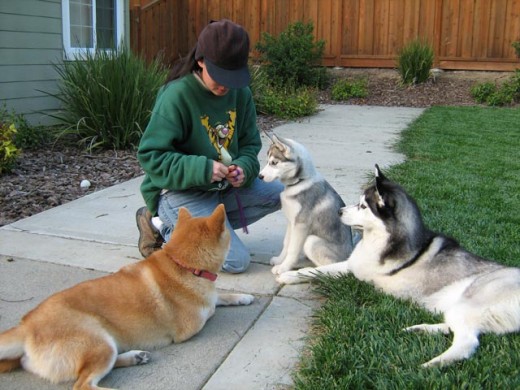
2. How to Encourage Good Behaviors
Puppy obedience training and even adult dog training is centered around two key areas-
- How to encourage and get puppy to repeat good behaviors.
- How to discourage and get puppy to stop bad behaviors.
It is important to recognize though that what we see as good and bad behaviors may not coincide with what our dog considers to be good and bad behaviors.
Dogs, even puppies, think for themselves and have needs of their own.
Therefore, we want to use our newly established communication system to teach our puppy what is good and bad for us. In addition, we must also motivate our dog so that she actually cares about our human values, which very likely, make little or no sense to her.


We encourage good behaviors by using the yes-mark, as soon as our dog finishes doing something good.
For example, when our puppy finishes doing a Sit we say “Good-Girl!” and then present her with a reward. The yes-mark is very helpful in training because it allows us to immediately mark the behavior that we want to reward.
To effectively train our puppy, we want to clearly indicate which action she is being rewarded for. If we wait too long, she will have moved on to something else, and we may inadvertently reward the wrong behavior.
Therefore, quickly use the yes-mark as soon as our dog finishes a good behavior. Then, we can take more time to present Puppy with her reward.

3. How to Stop Bad Behaviors
When it comes to stopping bad dog behaviors most of us think of applying a physical punishment, for example spanking the dog, jabbing the dog with our fingers, or giving the dog a collar correction.
These techniques apply pain to the dog, at which point the dog may stop her current behavior in order to avoid further pain and stress.
However, such pain based techniques are risky. If they are not executed with exactly the right force, timing, and redirection, they may cause more behavioral issues down the road; even aggression. It is especially risky to apply such techniques to puppies because of their young minds, and still developing bodies.
How then can we stop bad puppy behavior?

I have found that the best way to stop bad behavior is through the control of resources. *We* naturally control everything that a puppy wants, including food, toys, freedom, affection, and play.
To encourage good behaviors, we motivate our puppy by giving her something that she wants.
To discourage bad behaviors, we motivate our puppy by taking away something that she values, for example her freedom, or our attention and affection.
Note – This does not mean that we should tease our puppy and take away food while she is eating, or forcibly remove a toy that she is playing with. Doing so can encourage food aggression or resource guarding behavior.
What works best is to withhold something that my puppy wants, but does not yet have. Another possibility is to take away a privilege, such as withdrawing my attention or restricting her freedom.

When my puppy bites at my hands, I give her a no-mark (Ack-ack) and then redirect her to do something else, for example, chew on a toy. If Puppy redirects, I give her a yes-mark (Good-Girl), and reward her with something that she really wants, such as a yummy treat.
If Puppy ignores the no-mark and continues to bite at me, I withdraw my attention by standing up, folding up my arms, and turning away from her. In this way, she loses a valued play-mate, and no longer gets to engage in something fun.
If Puppy escalates her behavior and starts to jump on me or bite my clothes, I take away an even more important privilege; her freedom. I do this by calmly saying Timeout, and then taking my puppy to a boring but safe timeout area.
Puppies often bite at us to initiate play or to get our attention. We can effectively stop puppy biting by teaching her the following-
- Biting = No attention and no play,
- No biting = Attention, play, and treats.
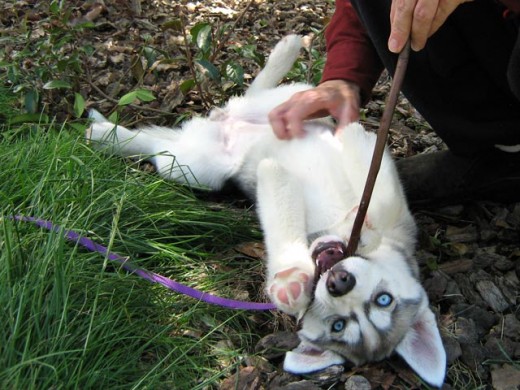
How to Train a Puppy
To stop bad behavior, I have found that it is important to –
- Start by redirecting Puppy into doing something positive. In this way, we turn a negative situation into a positive one. We not only get our dog to do what we want, but also teach her that following our commands, is the fastest way to get to her heart’s desires.
- Make the punishment suit the crime. I always start small and give my puppy many opportunities to choose a path for success. If she continues or escalates her bad behavior, then I slowly escalate her punishment.
- Stay calm at all times. Puppies have high energy and are easily distracted. If we get angry or frustrated, we will only inject more bad energy into an already volatile situation. This will likely cause our puppy to lose focus, become more hyper, and behave in an even more erratic fashion. If we want our dog to be calm, we must stay calm ourselves.
- Set Puppy up for success. Carefully manage our puppy and only expose her to situations that we think she can handle. For example, start by introducing her to new objects that are not moving, then slowly move on to moving objects, then objects that move and make noise, and so on. Start small and slowly move up to bigger things. The more successful a puppy is, the more confident she will become, and the more balanced she will be when she grows up.
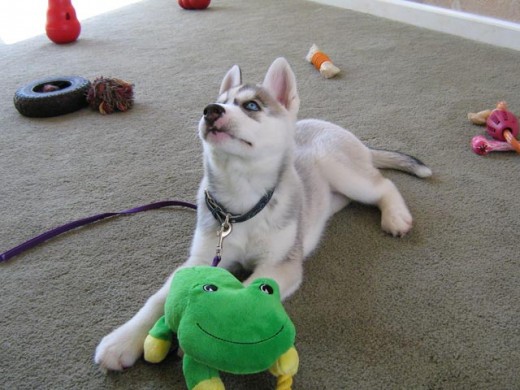
Goal of Puppy Obedience
The goal of puppy obedience is to learn how to communicate with our puppy, and teach her how to live well and harmoniously with us.
Obedience training can also help to protect our puppy from inadvertently harming herself and others, or from engaging in activities that may be detrimental to her health (e.g. over-eating, walking on glass).
Obedience training is *not* for acting out our anger, or venting our frustrations when our puppy poops on our furniture, eats poop, and spreads garbage all over our expensive designer couch.
We are not perfect, and Puppy is not perfect. In the initial stages, mistakes will be made, some of which may lead to chewed up designer shoes, scratched kitchen cabinets, and stained carpets. However, this is all part of the learning process.
Puppies, and indeed all dogs do not perform bad behaviors just to piss us off, make us angry, or exact revenge.
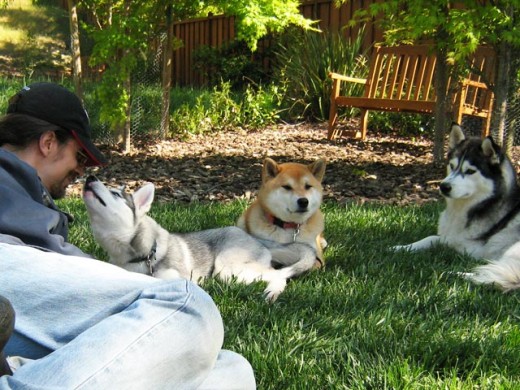
Puppies Acting Badly
Puppies or dogs act badly because …
- They do not know that something is bad because we did not teach them properly.
- They were stressed and started chewing, digging, or even pooping in order to relieve that stress (displacement behaviors).
- They felt threatened and thought it was necessary to protect themselves, or their belongings.
The key to puppy obedience training is in learning to see things from our dog’s point of view.
Once we understand what motivates our puppy, we can prevent undesirable actions and encourage desirable ones.
Dogs spend a lot of time observing us, understanding what makes us tick, and making us happy. The least that we can do, is try to return the favor.
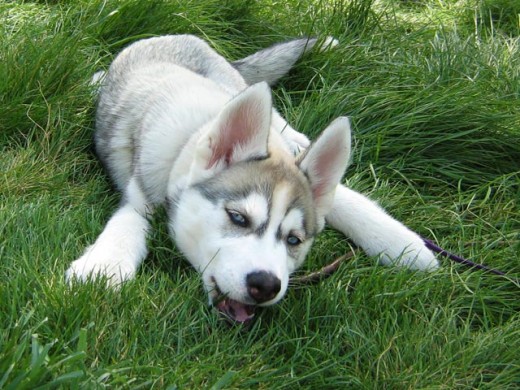
I have a 10 month old husky and I am having trouble establishing complete dominance. He listens to certain commands but he still pulls sometimes during our walks especially when he sees another dog. How do I get him to view me as the aplha?
It is natural for a young dog to get excited when exposed to interesting stimulus such as another dog, a running cat, a squirrel, etc. Siberian Huskies have a free and independent spirit, are high energy, more easily excitable, and they are also bred to pull, so it took some extra consistency and patience in leash training my Sibes. My Huskies also have very high prey drive.
I do dog-to-dog desensitization exercises to teach my dog to be calm and to relax in the presence of another dog.
http://shibashake.com/dog/dog-to-dog-aggression#desensitize
I manage my dog’s environment carefully so that I set them him up for success. In this way, I can slowly build up his tolerance for exciting stimulus and his ability for self-control.
However, my Huskies are not perfect nor do I expect them to be. They are an independent breed, and I enjoy that about my Sibes.
http://shibashake.com/dog/controlling-a-dogs-behavior-is-total-control-necessary
she is so hyper, very busy and never takes training seriously, I have tried everything to try get her to behave or to even listen when I say ‘no’ she chewed my phone this morning. In half! my mattress is in pieces from her biting it, as well as my cupboards, everything is chewed up. that is why I must send her to our farm. I hope it is the right decisions.
My Huskies really need human affection and supervision. They want and need to be with people a lot of the time. After walks I always check them for ticks and I also use a good tick prevention product. In addition, I vaccinate them against lyme disease because there are deer ticks in our area.
If I can no longer provide my dogs with these things, then I will do my very best and try my absolute hardest to find a good home for them, where they will get the love, supervision, and care that they deserve.
I just got a 4 week old husky what are your suggestions when potty training him? And what to feed him to grow bigger and stronger?
It is my first husky.
4 weeks old is really young to separate a puppy from his mother and siblings. In general, it is recommended that we wait until a puppy is at least 8 weeks old before taking him home. Here is why.
Also, when I get a new puppy, I take him to the vet as soon as possible to make sure that everything is ok, and to see what kind of vaccination schedule my vet would recommend.
How I potty-trained my Husky puppy.
How I pick food for my dogs.
However, *note* that I got all of my puppies at 8 weeks or older, so the experiences that I talk about in the articles above relate to puppies that are 8 weeks or older.
Our newest member of the family, a 12week old Siberian, is progressing pretty well. Thanks to the advice you wrote. There are times when we take her out for potty break and she just jumps into her new digging area and just goes into a crazed rage. This gets her so amped up she needs a 15 minute timeout just to claim down. I know digging is all part of the fun but this Tasmanian Devil aspect is hard to deal with. I have tried just taking her out leashed but I had hoped to develope an independence, and give me a break as well. Please advise, thanks
Hmmm, what do you mean by crazed rage? Is she doing over-excited playing or is it something else? What does she do? What are the behaviors that you want to stop? What is in her digging area?
Husky puppies have a lot of energy, so with Lara I try to direct her energy towards structured outlets. In general, I try to set up clear rules for everything, and I manage her excitement level by redirecting her focus back onto me. For example, after she does her business, she knows that I have some good rewards for her, so we do some recalls with very high priority rewards. Then, we may play something fun together, e.g. flirt pole. In this way, she has some structured but fun alternative outlets for her energy.
I manage her excitement level during play by having short but frequent play-breaks where we do very simple commands, e.g. Look, Sit, etc. She gets rewarded well for those, then we go back to playing. In this way, she refocuses on me, and has a chance to calm down. She also learns that these little breaks are rewarding, and then play gets to continue when she is calm.
Congratulations on your new Husky puppy! 😀
i have just got a Siberian husky, she is 6months old and Is the naughtiest puppy I have ever had, she chews furniture and when you try discipline her she barks and plays more and bites my clothes. I stay with family of a friend and they said I cannot keep her anymore because of her behaviour so she is going to my fathers house on a farm but my dad is never on the farm and she will be alone with two other dogs and the farm manager, I will only see her once a month if I can. I had a MultiMate husky and he was 10000% perfect on the farm, he was so happy but he died of tick bite fever and he was never this naughty. is it ok to send my puppy to this farm or must I sell her? I am madly inlove with this puppy and she is my baby, I am so confused on what to do…
Yeah my Sibes are independent minded and high energy, especially when young. They do best when they have
– A fixed routine and a consistent set of rules. More on how I set up routine and rules.
– Consistent training using resource control and positive reinforcement techniques. More on what I do to train my Husky not to bite on me or my clothes. I follow the Nothing in Life is Free program with my dogs.
– Many positive and structured activities to direct their energy. I direct my Huskies’ energy towards positive but fun activities so everyone has a good time and they learn good behaviors.
– Lots of time and supervision with their people.
– When in doubt, I get help from a good professional trainer. I had a lot of problems with my Shiba Inu, and I am very glad I got help with his training before considering more drastic alternatives.
http://www.aspca.org/pet-care/virtual-pet-behaviorist/finding-professional-help
My Huskies really enjoy and need to be with their people. Huskies are very intelligent and high energy, so they need interesting but supervised activities, structure, and training.
More on Siberian Huskies.
i have a 2 month husky puppy and i dont wnt him to bite the kids how do i do that.
With my dogs-
1. I always supervise closely whenever there are kids around and have my dog on a lead.
2. I teach my dogs to control the force of their bites with bite inhibition training.
3. I first train my dog not to bite on me. I socialize and desensitize my dog to people so that he will be comfortable and not get reactive.
4. I set up a fixed routine for my puppy and teach him self control.
5. I always try to set my dog up for success by only letting him greet calm kids who can follow my greeting rules. I make sure *not* to expose my dog to situations that he is not ready for, where he will lose control.
More on dog socialization.
ASPCA article on puppy socialization-
https://www.aspca.org/pet-care/virtual-pet-behaviorist/dog-behavior/socializing-your-puppy
How I meet a new dog.
Note however that dog behavior is very context dependent, so each dog and situation are different. When in doubt, I get help from a good professional trainer who can observe and evaluate my dog within the context of his regular routine and environment.
http://www.aspca.org/pet-care/virtual-pet-behaviorist/finding-professional-help
Hello, I have a huge problem with my puppy. She is 2 months old jack russel and she wouldn`t stop whining and crying, no matter day or night. All the time she wants to cuddle in my arms. We can`t leave her alone at home during the day, because she never gets tired crying. At night she falls asleep in her crate in the kitchen, but after an hour she starts whining again. And if I don`t move her with her crate in my bedroom, she wouldn`t stop. But even if I do, after an hour she`s awake again, crying and I need to comfort her in order to put her to sleep again. The situation is impossible for me and my family and I`m desperate. Please, help!
What is your puppy’s daily routine like? What does she do during the day? Has she been to the vet for a check-up?
When I get a new puppy, I find it helpful to set up a fixed routine and a consistent set of rules. Routine and structure help to create certainty, and certainty helps to reduce stress and fear.
In terms of alone time, I get my puppy used to that gradually. I start with very short periods of alone time (e.g. seconds) and slowly build up from there. More on how I train my dog to be comfortable with alone time. More on how I crate train my dog.
At night, my puppy sleeps in the bedroom with me, in his crate. I make sure that he can see me from his crate. In the beginning, I take my puppy out for potty breaks at night, as necessary. Being in the bedroom with me helps with bonding, and helps my puppy to relax because he is not alone. This is very important in the beginning, because my puppy just got separated from his mother and sibilings. In addition, he is in a totally new environment. Therefore, I want to make sure that I create a stable environment, where he feels safe.
During the day, I make sure to direct my puppy’s energy into positive and structured activities, including training exercises, bite inhibition exercises, grooming exercises, collar and leash desensitization, etc. Training my puppy will help him gain confidence and give me the tools to teach my puppy positive behaviors.
When I first got my Shiba Inu, I also enrolled him in a good puppy class that focuses on socialization. The instructor made sure to check all puppies for health and vaccination records.
https://www.aspca.org/pet-care/virtual-pet-behaviorist/dog-behavior/socializing-your-puppy
http://shibashake.com/dog/dog-socialization-what-why-how
With my Shiba, I also got help from several professional trainers who can observe and evaluate my dog based on his regular routine and environment. My trainer also helped me with timing, consistency, how to set up structure, management techniques, and more.
http://www.aspca.org/pet-care/virtual-pet-behaviorist/finding-professional-help
https://apdt.com/pet-owners/choosing-a-trainer/
Thank you, Shibashake! Last night she`s slept in our bedroom in her crate and she hasn`t been whining at all. We`ll try to calm her during the day as well, but it`s not going to be easy, because in the minute she finds herself alone in the room, she starts whining and scratching the doors.
That is really great to hear! Happy New Year to everyone and big hugs to your pup. 😀
Saturday I will be bringing home two 9 week old huskies from the same liter. Is it alright to keep them in the same crate or should they have their own space? Thank you!!!
I forgot to ask. Is a furminator a good tool for a husky? I have read different views on it.
I have only taken in one puppy at a time, so I am not sure. I have my hands very full with just one puppy. They are very a lot of work, very energetic, and require a lot of attention, especially during puppyhood. 😀
First 10 days with my Husky puppy Lara.
I have seen my breeder keep two puppies in the same crate, depending on temperament. It seems fine, but I don’t have first hand experience with this.
I find the Furminator to be useful for my Huskies. However, I slowly get them used to grooming, first with a softer brush. Then, I am careful about how much force I use when furminating, especially on more sensitive parts of their bodies.
http://shibashake.com/dog/siberian-husky-facts#shed
Some dogs are more sensitive, so it really depends on the dog. I adjust what I use accordingly.
Congratulations on your upcoming pups! 😀
Hello,
I am getting a samoyed puppy soon and was wondering how your fixed schedule was with your youngest Husky? I have an idea of how I’m going to make the schedule but I want something good to go off of. 🙂
Congratulations on your upcoming puppy! I love Samoyeds! Please post us some puppy pictures when you get your furball. 😀
http://shibashake.com/dog/exercise-your-dog/comment-page-1#comment-609736
We just got our husky puppy 2 weeks ago and he is now 3 months old. We are already teaching him tricks like sit, down, stay and he is doing quite good with those.
However, the biggest issue is the recall command. When I have a treat in my hand and he knows it, he will come when called for the reward, but as soon as I am without the reward he just ignores us and goes around backyard. And if we follow him, he just runs further. We have a very big yard and he is living outside with another dog, so he is free to run around during the day or night, when he wants to. So when he comes to us, we’re not taking his freedom away or anything.
So do you have any advice how to improve this and eventually teach him to come every time he is called and stop ignoring us?
What is he usually doing when you call? What usually happens when he comes to you? What type of training is he used to? What is his daily routine like? Does he get all his food outside? What does he like to do?
With my dogs, I follow the Nothing in Life is Free program. It is a great way to teach them to work for the things that they want, and they also learn that people are the source of good stuff. I use food, play time, affection, going out into the backyard, and more, as rewards, and mix them up.
It is important to get a good recall, so I always use really good stuff for that, including play-time which my young Husky really loves. I reward especially well in the beginning, and I keep up with rewarding well for recalls. Having a good recall is very useful and can be extremely important when accidents (e.g. collar slips) occur. Which rewards work well will depend on the dog and what he loves to do.
Sibes are an independent breed though and they generally do have high prey drive. My Huskies are pretty good about coming when called, but if there is a cat or squirrel about, then all bets are off. This is why it is generally recommended that Huskies be exercised on-leash or in-harness when in a non-enclosed area.
During puppyhood, I also have my Husky puppy inside the house, with me, most of the time. I hand-feed her a lot of her food, for bite inhibition training, and it also helps with bonding. I play with her inside the house, and she gets most of her food inside the house, through obedience, grooming, following rules, and more. She knows that when I call, it is usually for something fun and good, so she will come, unless there is a much stronger competing motivation. A puppy usually likes following people around, so it is a great time to do recall training.
In general, I always try to set my dog up for success. The more successful recalls there are, the more my dog learns to come when called, and the more I can reinforce the behavior. If she does not come when I call, then I always go fetch her. In this way, she learns that –
Coming when called = Play time, food time, and lots of good stuff,
Not coming when called = Get fetched anyway without the good stuff,
and recall always means she ends up coming with me.
I don’t chase after my dog, because that will likely cause her to run away, thinking that it is a game of chase. Usually, she doesn’t come because she is obsessed with another animal, so I can fetch her because she is in a given area. Some people may also use a drag-lead or long-line during recall training, but this is only under close supervision and only with a flat collar or harness (no aversive collars). It is important to make sure that our dog does not get hurt if the line should briefly catch on something.
This article from the ASPCA has more on recall training-
http://www.aspca.org/pet-care/virtual-pet-behaviorist/dog-behavior/teaching-your-dog-come-when-called
Thanks for the answer. To answer some of your questions, when I am struggling to recall him, he is usually sniffing around the big yard we have, and keeps running away each time I get closer to him. I believe he thinks we are playing a game… When he is in this “mood”, I have to chase him for a while to catch him and then if I punish him with taking away freedom for a while, I’m not even sure if he would understand that correctly?
He is always rewarded when coming to a recall, either with a treat or play time, but I’m not sure how exactly should I “punish” him when he is not coming to a recall and if I go catching him around the yard?
He eats and lives outside together with another dog.
Yeah, I do not chase after my dog for recall because as you say, that becomes a fun game and rewards the dog for not coming. As I described above, we can prevent chasing games by using a lead or long-line, but only under supervision and only with proper equipment. Check out the ASPCA article for more. It has a lot of useful information.
I never punish my dog for recalls. Recall training is all about making a dog want to come to me, therefore, even if I have to fetch my dog or use a long-line, I never punish him.
The key with recall training, for me, is to set my dog up for success. I want to maximize successes and minimize failed recalls. Therefore, I do recall training with extremely high priority smelly food, e.g. sardines, that he only gets during recall training. The smell helps to engage his interest early on. Then, I can further increase my chances of success by managing the environment and calling him when he is most likely to come. In this way, I can consistently reinforce his coming to me behavior, which will make him want to keep repeating that behavior. I keep doing these exercises until I have a good recall.
Once I have a solid recall, then I can slowly increase the timing and environment challenge. However, I always start small and set my dog up for success.